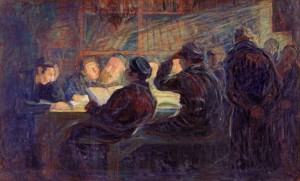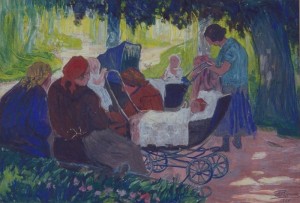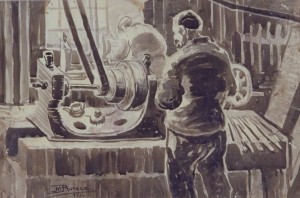JEWISH FAITH GALLERY
 Judaism is a monotheistic religion, philosophy, and way of life. While raised in an Orthodox Jewish environment, Moshe practiced a somewhat more reformed version of Judaism. He did, however, feel a deep connection to the religious portion of the Jewish community and he sought to respectfully record Jewish worship and religious study. This gallery contains paintings that captures the beauty of the sanctuary inside the synagogue as well as the dedication of religious scholars to their studies. See the Jewish Faith Gallery.
Judaism is a monotheistic religion, philosophy, and way of life. While raised in an Orthodox Jewish environment, Moshe practiced a somewhat more reformed version of Judaism. He did, however, feel a deep connection to the religious portion of the Jewish community and he sought to respectfully record Jewish worship and religious study. This gallery contains paintings that captures the beauty of the sanctuary inside the synagogue as well as the dedication of religious scholars to their studies. See the Jewish Faith Gallery.
FAMILY & COMMUNITY GALLERY
 Jewish identity contains elements of national pride, genealogical ancestry, and religious practice. The Jewish people have a long history of living under many different rulers, some who allowed Jews to live peacefully within their borders, and others who have exiled them from their lands. While living in such a diasporic condition, Jews have held onto their identity and history, but have often been influenced by the communities and cultures in which they have carved out their own communities. The paintings in this gallery reflect both the cultural components of the Jewish community (e.g., wedding celebrations, divorce, and death) as well as more leisurely activities (e.g., men playing chess, children playing in the streets). While many of Moshe’s paintings captured the joy and happiness enjoyed by the Polish Jewish community of the 1920s and 1930s, his later paintings document life inside the Warsaw Ghetto where he witnessed first-hand the repression, tyranny, and cruelty inflicted upon the Jews by Hitler and his Nazi regime. See the Family & Community Gallery.
Jewish identity contains elements of national pride, genealogical ancestry, and religious practice. The Jewish people have a long history of living under many different rulers, some who allowed Jews to live peacefully within their borders, and others who have exiled them from their lands. While living in such a diasporic condition, Jews have held onto their identity and history, but have often been influenced by the communities and cultures in which they have carved out their own communities. The paintings in this gallery reflect both the cultural components of the Jewish community (e.g., wedding celebrations, divorce, and death) as well as more leisurely activities (e.g., men playing chess, children playing in the streets). While many of Moshe’s paintings captured the joy and happiness enjoyed by the Polish Jewish community of the 1920s and 1930s, his later paintings document life inside the Warsaw Ghetto where he witnessed first-hand the repression, tyranny, and cruelty inflicted upon the Jews by Hitler and his Nazi regime. See the Family & Community Gallery.
AT WORK GALLERY
 The contribution Jews have made to literature, music, science, medicine, philosophy, and entertainment is staggering. Of course not everyone from the Jewish community has made contributions that have changed the course of history. Some just worked regular jobs to provide for their families. These are the people Moshe painted at work—the lathe worker, the toy maker, the machine expert. This gallery showcases the life of the physical laborer as well as those who relied upon machines to help them complete their tasks. See the At Work Gallery.
The contribution Jews have made to literature, music, science, medicine, philosophy, and entertainment is staggering. Of course not everyone from the Jewish community has made contributions that have changed the course of history. Some just worked regular jobs to provide for their families. These are the people Moshe painted at work—the lathe worker, the toy maker, the machine expert. This gallery showcases the life of the physical laborer as well as those who relied upon machines to help them complete their tasks. See the At Work Gallery.
About the Work
Jewish Art History cannot be simply subsumed into a generalized European art history. The modern artist as the author-agent of the work of art is a relatively new persona and figure for Jews, emerging only in the nineteenth century along with greater historical movements of emancipation for Jews in Europe. Moshe Rynecki himself is split between affinities: on the one hand, he is a painter of traditional Jewish life in Poland, settling his gaze upon scenes of synagogue, teaching, labor, and leisure. On the other hand, his self-portraits reveal a man apart from the world he depicts, a modern subject rendered in a minimalist style with expressionist lines in contemporary and not traditional dress. Moshe’s dual identity as a Jew, and as a member of the growing middle class in the more secular setting of Warsaw, allowed him to intimately paint aspects of Jewish life and tradition and yet to distance himself to position himself as an ethnographer of the community, and a witness to its demise and destruction.